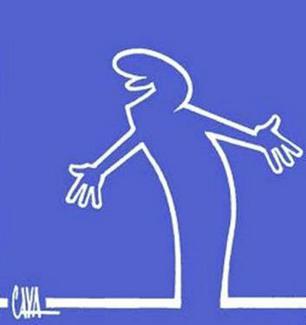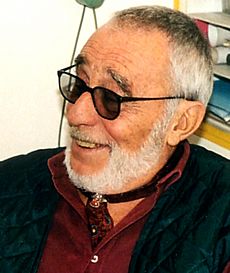La Linea (TV series) facts for kids
Quick facts for kids La Linea |
|
|---|---|

La Linea
|
|
| Genre | Animation, Comedy |
| Created by | Osvaldo Cavandoli (Cava) |
| Voices of | Carlo Bonomi (all voices) |
| Theme music composer | Franco Godi |
| Country of origin | Italy |
| Original language(s) | Grammelot |
| No. of seasons | 3 |
| No. of episodes | 90 |
| Production | |
| Running time | 2-6 minutes |
| Production company(s) | B. Del Vita (season 1) HDH Film/TV (season 2) |
| Distributor | QUIPOS |
| Release | |
| Original network | RAI |
| Original release | 1971 – 1986 |
| Chronology | |
| Related shows | Carosello |
La Linea (which means "The Line" in Italian) is a famous Italian animated series. It was created by a talented cartoonist named Osvaldo Cavandoli. The show first aired in Italy on the RAI channel. It ran from 1971 to 1986. There are 90 episodes in total. The catchy background music was made by Franco Godi.
The main character is called "Mr. Linea." He is drawn as a simple outline. He walks along an endless line. As he walks, he runs into all sorts of funny problems. When he needs help, he often turns to the cartoonist. The cartoonist's hand appears on screen. It uses a pencil to draw solutions for Mr. Linea.
Each episode is quite short. They usually last between 2 and 7 minutes. La Linea became very popular around the world. It was shown in over 50 countries. Because the episodes are so short, TV channels often used them. They filled small gaps between other shows or commercials. Many people consider La Linea a cult classic. This means it's a show that has a strong, dedicated fanbase.
The show also inspired other things. These include comic strips and books. There were also short movies and toys. Many other shows have paid tribute to La Linea. Mr. Linea has appeared in different types of media too. Even though some episodes are numbered up to 225, there are only 90 actual La Linea episodes. You can also find all the episodes on DVD today.
Contents
What is La Linea About?
The cartoon stars a character known as "Mr. Linea." He is drawn as a single outline. He walks on a line that seems to go on forever. He is actually part of this line himself.
Mr. Linea often faces different challenges. Sometimes, the line he is walking on suddenly ends! He might almost fall off the edge. When this happens, he gets upset. He turns to the cartoonist for help. The cartoonist's hand then appears. It holds a white pencil. The hand tries to draw a solution for Mr. Linea. Sometimes it works perfectly, and sometimes it doesn't!
How La Linea Was Made

In 1969, Osvaldo Cavandoli had an idea for a new character. He called him "Mr. Linea." Cavandoli showed his idea to advertising companies. These companies made short films for a show called Carosello.
An engineer named Emilio Lagostina liked the character. He owned a company that made pressure cookers. Lagostina wanted Mr. Linea to star in commercials for his products. The character was first called Agostino Lagostina. This name was later removed.
The description of the character was: "Who is Agostino? A lively little man, with a truly expressive nose, with all the concerns and worries of modern life. Son of a pencil and a hand."
Carlo Bonomi provided all the voices for Mr. Linea. He spoke in a made-up language. It sounded a lot like gibberish. This made it easy for the cartoon to be shown in many countries. It did not need to be dubbed into other languages. Bonomi also voiced the character Pingu. The background music was put together by Franco Godi and Corrado Tringali.
The first 8 episodes were made to advertise Lagostina kitchen products. In these early episodes, a narrator would introduce Mr. Linea. After a while, the show stopped being connected to Lagostina. Mr. Linea then became the star of his own TV series. It became very successful all over the world. More than 90 episodes were eventually made.
La Linea Around the World
From 1972 onwards, La Linea was shown on many TV stations. It also appeared in cinemas across Europe. It was often used as a short filler between commercials. La Linea was shown in more than 50 countries. The series won awards in 1972 and 1973.
- In the United States, the cartoons were part of a children's TV show. It was called The Great Space Coaster. The characters on that show would give La Linea different names. Not all La Linea cartoons were shown. Some had themes that were not suitable for children.
- It was also featured in the International Animation Festival by KQED Inc. in the 1970s.
- La Linea was also shown on Nickelodeon. It was part of their animated shorts during Pinwheel.
- In the United Kingdom, La Linea aired on ITV (CITV) from 1983 to 2003. It later appeared on ITVBe and Channel 4.
- In Canada, La Linea cartoons aired on Radio-Canada and TVO.
- In South Africa, it was shown on SABC-TV in the late 1970s and early 1980s. It filled gaps between shows.
- The Australian Broadcasting Corporation showed it in Australia. It was used as a filler between longer programs.
- From June to October 2008, a Norwegian newspaper called Dagbladet published all episodes. They were shown daily on its website.
DVD Releases
A set of three DVDs with all episodes came out in Germany in 2003. It was re-released in 2008. The first DVD volume was also released in France, Hungary, Serbia, and Scandinavia. In 2008, a two-DVD set with 56 episodes was sold in Quebec. The complete series was released in Scandinavia in early 2008. It came in a 3-disc box set.
Other Media
Comic Strip
Osvaldo Cavandoli also turned his animated cartoon series into a comic strip. This comic strip won many international awards.
Different Names for the Show
The show is known by different names around the world. Here are some of them:
- "Bay Meraklı" (Mr. Curious) and "Çizgi Adam" (Line Man) in Turkey
- "Aghaaye Khat" / "آقای خط" (Mr. Line) in Iran
- "Linus på linjen" (Linus on the line) in Sweden
- "Linus linjalla" (Linus on the line) in Finland
- "Linea" or "Badum Badum" in Slovenia
- "Balum balum" and sometimes "Złośniczek" in Poland
- "Menő Manó" (Walking Dwarf or Cool Dwarf) in Hungary
- "Mar Kav" / "מר קו" (Mr. Line) in Israel
- "Barum Badum" in Albania and Kosovo
- "Streken" (The Line) in Norway
- "Stregen" (The Line) in Denmark
- "Línan" (The Line) in Iceland
- "Бајум Бајум" in North Macedonia
- "Барум Барум" / "Barum Barum" or "Абаракандиши Ди Фјури" / "Abarakandiši Di Fjuri" in Serbia
- "Lineman" in the United States
- "La Linéa" in France
- "A Linha" in Brazil
- "Abelardo" in Argentina
- "La ligne" in Québec, Canada
- "Bajum Badum" in Croatia
- "Μπαρούμ Μπαρούμ" - Barúm Barúm Greece
- "AlSeyed Khat" / "السيد خط" (Mr. Line) in Saudi Arabia
- "Xiàntiáo xiānshēng" / "線條先生" (Mr. Line) in China
See also
 In Spanish: La línea (serie de televisión) para niños
In Spanish: La línea (serie de televisión) para niños

